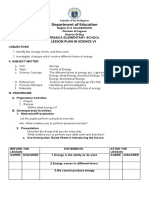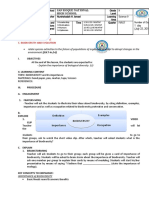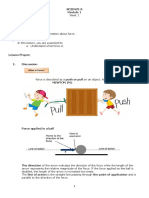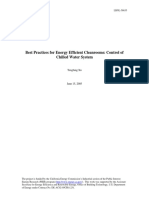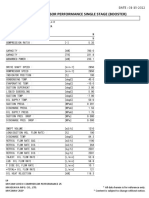dll-10 CO
dll-10 CO
Uploaded by
Rochelle UlgadoCopyright:
Available Formats
dll-10 CO
dll-10 CO
Uploaded by
Rochelle UlgadoOriginal Description:
Original Title
Copyright
Available Formats
Share this document
Did you find this document useful?
Is this content inappropriate?
Copyright:
Available Formats
dll-10 CO
dll-10 CO
Uploaded by
Rochelle UlgadoCopyright:
Available Formats
School: Grade Level: VI
GRADES Teacher: Learning Area: SCIENCE
1 to 12 Teaching
DAILY Dates
LESSON LOG and
Time: November 19, 2019 Quarter: 3RD QUARTER
I. OBJECTIVES
The learners demonstrate understanding how energy is
A. Content Standards transformed
The learners should be able to create a marketing strategy for a
B. Performance Standards new product on electrical or light efficiency
C. Learning Competencies/ The learner should be able to demonstrate how sound, heat, light
Objectives and electricity can be transformed
Write the LC code for each
II. CONTENT
ENERGY TRANSFORMATION
S6FEIIId-f-2
III. LEARNING RESOURCES
A. References
1. Teacher’s Guide pages
2. Learner’s Materials pages
3. Textbook pages
4. Additional Materials from
Learning Resource (LR) portal
B. Other Learning Resources
IV. PROCEDURES
A. Reviewing previous lesson or Pass the ball. When the music stops, pupils will get pictures in
presenting the new lesson the box and tell what type of energy is that.
B. Establishing a purpose for the Show a picture of a man moving
lesson
1. What can you say about the picture?
2. What makes a man moving?
3. Where do we get this energy?
4. How long does your food digest in your stomach and used as
energy? If you eat at 6 in the morning, what time does the food is
fully digested?
4. What do you call this kind of process?
C. Presenting examples/instances of Set up a student centered station lab and allow the pupils to
the new lesson explore energy transformations.
Station 1: Watch it – At this station, pupils will be watching a
short video explaining energy. Pupils will then answer questions
related to the video.
Station 2: Illustrate it – Pupils are to draw their knowledge of
energy transformations
Station 3: Organize it – Pupils will match the sets of cards.
Cards include objects and energy transformations that the pupils
will work to determine which would be much
Station 4: Read it –This station will provide pupils with a one
page reading about energy transformations. There are follow up
questions that the pupils will answer to show reading
comprehension of the subject
Station 5: Manipulate it – Pupils will be given different object
to operate and answer related questions
D. Discussing new concepts 1. Based on the activity, what do you mean by energy
transformation?
2. What are the different types of energy that can be converted?
3. What is an example of potential energy being transformed into
kinetic energy?
4. What is the usual product of energy transformation?
5. How does energy transformation happen?
6. Why do you think energy transformation is important?
E. Continuation of the discussion of
new concepts (leads to Formative
Assessment 2)
F. Developing mastery (leads to Energy Flows
Formative Assessment 3) How can you use the energy in sunshine to make music?
Put the correct objects in sequence to make the energy flow
G. Finding practical applications of
concepts and skills in daily living
H. Making generalizations and What is energy transformation?
abstractions about the lesson
I. Evaluating learning Choose the letter of the best answer.
1. Which of the following show that the electrical energy
transformed into heat energy?
a. light candle b. glue gun c. flashlight d. telephone
2. Which of the following shows the mechanical- sound energy
change?
a. rice cooker b. alarm clock c. flat iron d. oven toaster
3. What energy transformation is present in microwave oven?
a. electric energy to chemical energy
b. electric energy to nuclear energy
c. electrical energy to mechanical energy
d. electrical energy to heat energy
4. Which of the following is a by-product of energy
transformation
a. heat b. light c. sound d. electricity
5. When does a form of energy become useful to us?
a. when it is a conserved or saved
b. when it is stored in chemical energy
c. when it is changed into another form
d. when it is released into the atmosphere
J. Additional activities for List 5 objects and tell how energy transform
application or remediation
V. REMARKS
VI. REFLECTION
A. No. of learners who earned 80% in
the evaluation
B. No. of learners who require
additional activities for
remediation
C. Did the remedial lessons work?
No. of learners who have caught
up with the lesson
D. No. of learners who continue to
require remediation
E. Which of my teaching strategies
worked well? Why did these
work?
F. What difficulties did I encounter
which my principal or supervisor
can help me solve?
G. What innovation or localized
materials did I use/discover which
I wish to share with other
teachers?
You might also like
- Infer That Waves Carry Energy : Group Rotations Are Valuable For Keeping The Whole Class EngagedNo ratings yetInfer That Waves Carry Energy : Group Rotations Are Valuable For Keeping The Whole Class Engaged10 pages
- Grade Level Learning Area Quarter: School Teacher Date/TimeNo ratings yetGrade Level Learning Area Quarter: School Teacher Date/Time4 pages
- Pandacaqui Resettlement Elementary School Semi-Detailed Lesson Log in Health 6 PresNo ratings yetPandacaqui Resettlement Elementary School Semi-Detailed Lesson Log in Health 6 Pres4 pages
- Daily Lesson LOG School: Grade Level: Teacher: Science Teaching Dates/Time: Quarter100% (1)Daily Lesson LOG School: Grade Level: Teacher: Science Teaching Dates/Time: Quarter3 pages
- Department of Education: Tumalim National High School100% (1)Department of Education: Tumalim National High School6 pages
- I. Objectives: Name of The School Grade Level Name of The Teacher Learning Area Date & Time QuarterNo ratings yetI. Objectives: Name of The School Grade Level Name of The Teacher Learning Area Date & Time Quarter2 pages
- A Detailed Lesson Plan in Science Iv I. ObjectivesNo ratings yetA Detailed Lesson Plan in Science Iv I. Objectives5 pages
- SCIENCE 6 PPT Q3 W4 - Electrical Energy To Sound Energy100% (1)SCIENCE 6 PPT Q3 W4 - Electrical Energy To Sound Energy23 pages
- The Learners Demonstrate An Understanding ofNo ratings yetThe Learners Demonstrate An Understanding of3 pages
- The Learners Demonstrate An Understanding of100% (1)The Learners Demonstrate An Understanding of3 pages
- Iloilo Province Grade 9 Chemistry - Matter: Rosalina B. Inarsolin-Botong-Cabanbanan NHSNo ratings yetIloilo Province Grade 9 Chemistry - Matter: Rosalina B. Inarsolin-Botong-Cabanbanan NHS7 pages
- Monday Tuesday Wednesday Thursday Friday: GRADES 1 To 12 Daily Lesson LogNo ratings yetMonday Tuesday Wednesday Thursday Friday: GRADES 1 To 12 Daily Lesson Log7 pages
- Classroom Observation Lesson Plan in Science 6No ratings yetClassroom Observation Lesson Plan in Science 63 pages
- SCHOOL YEAR: 2022-2023 Grade Level Teacher Learning Area Teaching Date Quarter I. ObjectivesNo ratings yetSCHOOL YEAR: 2022-2023 Grade Level Teacher Learning Area Teaching Date Quarter I. Objectives5 pages
- EXEMPLAR SCIENCE LESSON PLAN-Menstrual Cycle100% (1)EXEMPLAR SCIENCE LESSON PLAN-Menstrual Cycle7 pages
- Instruction Manual: PMG Voltage Regulator Model: XR2002/XR2002FNo ratings yetInstruction Manual: PMG Voltage Regulator Model: XR2002/XR2002F21 pages
- Sepcification of PSGSG149 CABLE TERMINATION PDFNo ratings yetSepcification of PSGSG149 CABLE TERMINATION PDF10 pages
- Best Practices For Energy Efficient Cleanrooms: Control of Chilled Water SystemNo ratings yetBest Practices For Energy Efficient Cleanrooms: Control of Chilled Water System6 pages
- Electrical Load Calculation & Energy Consumption (26.11.12) .No ratings yetElectrical Load Calculation & Energy Consumption (26.11.12) .253 pages
- Disclosure To Promote The Right To InformationNo ratings yetDisclosure To Promote The Right To Information31 pages
- Physical Science: Quarter 3 - Module 8: "Coollide"No ratings yetPhysical Science: Quarter 3 - Module 8: "Coollide"17 pages
- CVT Secondary Sub-Circuits (Var Control)No ratings yetCVT Secondary Sub-Circuits (Var Control)2 pages
- Neutral Point Clamped MOSFET Inverter WithNo ratings yetNeutral Point Clamped MOSFET Inverter With13 pages
- Prof Ir Dr. Ab Saman B. Abd Kader, Peng, Miem, Mcit: Faculty of Mechanical Engineering, UtmNo ratings yetProf Ir Dr. Ab Saman B. Abd Kader, Peng, Miem, Mcit: Faculty of Mechanical Engineering, Utm24 pages
- Physics Notes Class 11 CHAPTER 11 THERMAL Properties of MatterNo ratings yetPhysics Notes Class 11 CHAPTER 11 THERMAL Properties of Matter9 pages
- 5 Year Annual Transmission Capability Statement 2020-2024No ratings yet5 Year Annual Transmission Capability Statement 2020-2024215 pages
- Power Electronics PSPICE Lab User Manual: An Iso 9001:2008 Certified OrganizationNo ratings yetPower Electronics PSPICE Lab User Manual: An Iso 9001:2008 Certified Organization19 pages
- Cell Failure Mechanisms in PEM Water ElectrolyzersNo ratings yetCell Failure Mechanisms in PEM Water Electrolyzers10 pages



